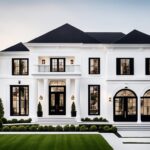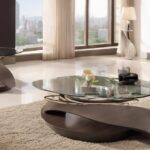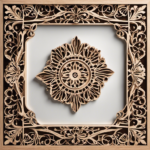Architecture Home Styles
The 5 Most Popular Wood Trim Styles for Your Home
Jazz up your living space with the top 5 wood trim styles that promise to transform your home – discover the perfect match for your design vision.
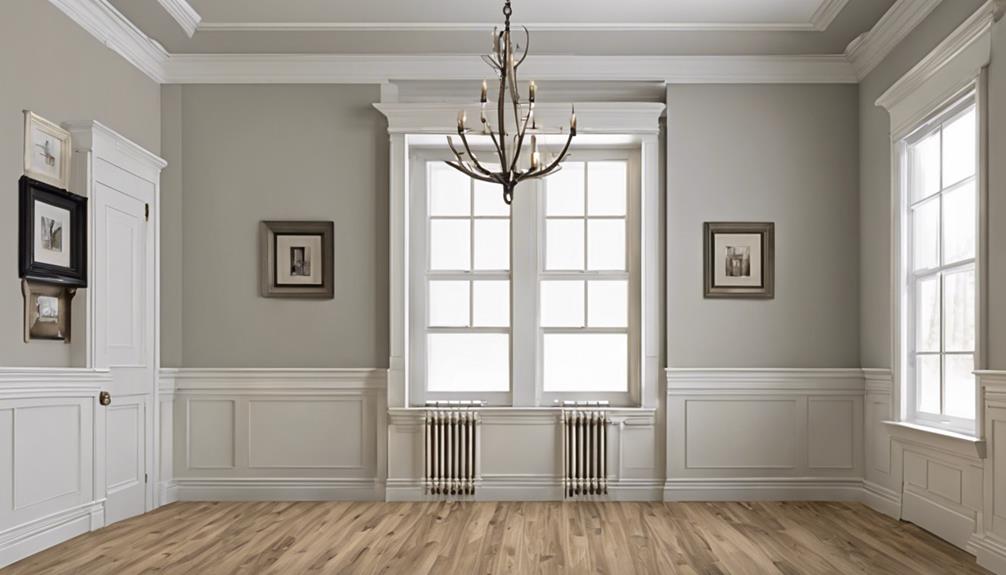
When it comes to enhancing the visual appeal of your living space, choosing the right wood trim styles can make a significant difference.
Our selection of the five most popular wood trim styles offers a diverse range of options to suit various design preferences and elevate the ambiance of your home.
From adding a touch of elegance to your kitchen cabinets to creating a modern exterior look, these styles cater to a multitude of tastes and aesthetics.
Whether you're aiming for a classic charm or a contemporary flair, exploring these wood trim options might just inspire your next home improvement project.
Key Takeaways
- Classic Crown Molding and Elegant Chair Rail Detail offer timeless elegance and increase home value.
- Modern Minimalist Trim provides a sleek, minimalist design for contemporary homes, enhancing sophistication.
- Rustic Reclaimed Wood Trim adds warmth and character, supporting sustainability and authentic home decor.
- Wood trim styles offer design flexibility, customization options, and a range of materials to blend with any decor.
Classic Crown Molding
Classic crown molding adds a touch of timeless elegance to any room, seamlessly blending the walls and ceilings with its sloped design. The beauty of crown molding lies in its ability to enhance the architectural details of a space, creating a polished and sophisticated look. Available in a variety of profiles and sizes, this classic wood trim can complement a range of architectural styles, from traditional to modern. The intricate details of crown molding not only add visual interest but also elevate the overall aesthetic appeal of a room.
When considering a home renovation project, installing crown molding can be a simple yet effective way to increase the perceived value of your home. By framing the junction between walls and ceilings, crown molding creates a seamless transition that exudes charm and character. Whether you opt for a more elaborate design or a simpler profile, classic crown molding is sure to make a lasting impression on any space.
Modern Minimalist Trim

Embracing sleek lines and minimalist design, modern minimalist trim offers a sophisticated touch to contemporary homes, emphasizing clean aesthetics and understated elegance. The beauty of modern minimalist trim lies in its ability to create a sense of openness and simplicity within a space. With straight edges and smooth finishes, this trim style effortlessly complements modern interior designs, allowing the architectural elements of a room to shine without overwhelming the overall look.
In modern minimalist trim, wood choices like maple, oak, and cherry are popular for their natural and sophisticated appeal. These woods bring warmth and texture to the clean lines of the trim, adding a touch of organic beauty to the uncluttered design. By choosing modern minimalist trim, homeowners can achieve a cohesive and harmonious visual flow in their space, focusing on the beauty of simplicity and the allure of understated elegance.
Rustic Reclaimed Wood Trim
Crafted from weathered barn boards and aged beams, rustic reclaimed wood trim exudes a timeless charm that embraces the essence of history within your home's interior. Here are some key points to consider when incorporating this popular style of wood trim:
- Character and Warmth: Rustic reclaimed wood trim adds a unique touch with its textures and imperfections, creating a cozy atmosphere in any room.
- Eco-Friendly Choice: By repurposing wood from old structures, rustic reclaimed wood trim contributes to sustainability and reduces environmental impact.
- Customizable and Versatile: Whether your decor leans towards modern, farmhouse, or traditional styles, you can customize the finish of reclaimed wood trim to seamlessly blend with your interior design.
Enhancing your walls with rustic reclaimed wood trim not only brings a sense of history and charm to your space but also reflects your commitment to sustainable and authentic home decor.
Elegant Chair Rail Detail
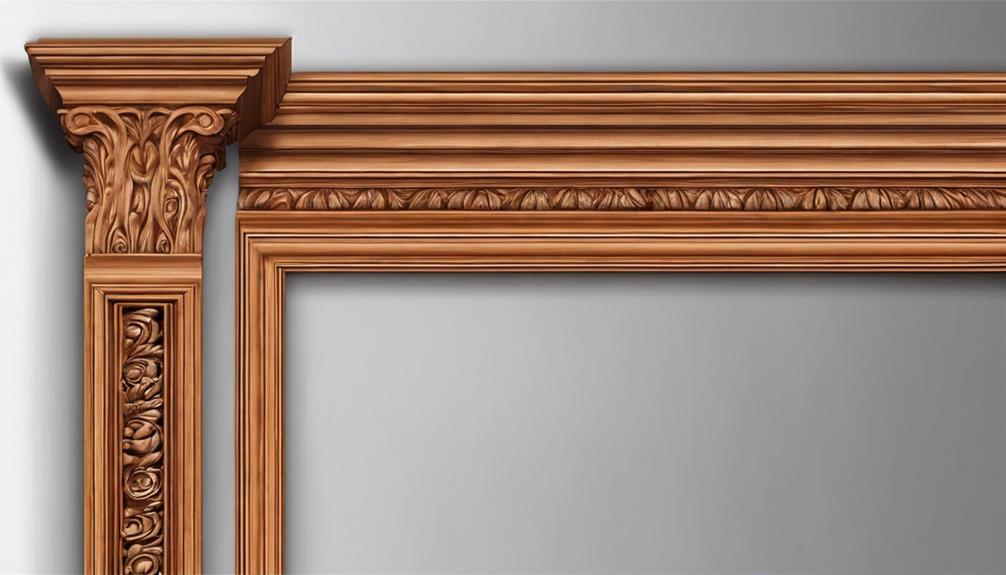
Enhancing the walls of your home with an elegant chair rail detail can effortlessly elevate the sophistication and visual appeal of any room.
Chair rails, originally designed to protect walls from chair backs, have evolved into decorative elements that can significantly enhance a room's ambiance.
These versatile trims, available in various styles, heights, and materials, can be painted or stained to seamlessly blend with your existing decor, offering a customizable design feature.
Installing chair rails is a straightforward DIY project that can yield impressive results, adding an elegant detail that exudes sophistication and elegance.
Sleek Baseboard Profiles
We love how sleek baseboard profiles effortlessly add a modern touch to room interiors, providing a clean and balanced finish without overwhelming the space.
Here are some key points to consider when opting for sleek baseboard profiles:
- Height Matters: Sleek baseboard profiles typically range from 3 to 5 inches in height, offering a balanced look that suits modern homes perfectly.
- Minimalist Appeal: Baseboards with simple designs and straight lines create a timeless and versatile option that complements various decorating styles, making them a popular choice among those who prefer a minimalist aesthetic.
- Color Choices: Opting for white or ivory colors for your baseboards can add a classic touch to interior spaces. These neutral tones blend seamlessly with different design schemes, ensuring a sleek appearance that enhances the overall look of the room.
Frequently Asked Questions
What Is the Most Popular Wood Trim?
The most popular wood trim style can vary depending on personal taste and home decor. Craftsman wood trim offers clean lines and simplicity for a timeless look.
Colonial wood trim features elegant details like fluting and rosettes, adding a classic touch.
Farmhouse trim brings a rustic charm with elements like shiplap.
Victorian trim showcases intricate designs for a grand aesthetic.
Modern trim emphasizes sleek, minimalistic profiles for a contemporary feel.
What Baseboards Are in Style for 2023?
We've got our fingers on the pulse of style, and for 2023, baseboards are making a statement.
The trend leans towards classic and versatile options, like timeless white or ivory choices. These baseboards typically stand between 3 to 5 inches tall, offering that perfect balance for any room.
Embracing the clean finish they provide, we can't deny the aesthetic boost these classic baseboard styles bring to our living spaces.
What Trim Is Trending Now?
We're excited to share that the latest trend in trim is all about embracing bold and modern colors! Whether it's a sleek charcoal gray or a striking black, these choices can transform your home's exterior into a contemporary masterpiece.
What Are the Four Most Popular Moulding Profiles?
We're delving into the realm of interior design wonders, uncovering the top trim styles that redefine a space.
The sought-after moulding profiles that reign supreme are crown moulding, chair rail, baseboards, and casing. Each of these profiles brings its unique charm, from the regal touch of crown moulding to the protective embrace of chair rail.
Baseboards elegantly bridge the wall-floor gap, while casing frames doors and windows with finesse.
Conclusion
In conclusion, the versatility and charm of these popular wood trim styles can truly transform any space into a stunning masterpiece. From the classic elegance of crown molding to the sleek modern lines of minimalist trim, the options are endless.
So go ahead, add a touch of rustic charm with reclaimed wood trim or create a sophisticated look with elegant chair rail detail. The possibilities are as vast as the beauty they bring – it's like a symphony for your senses!
- About the Author
- Latest Posts
Introducing Ron, the home decor aficionado at ByRetreat, whose passion for creating beautiful and inviting spaces is at the heart of his work. With his deep knowledge of home decor and his innate sense of style, Ron brings a wealth of expertise and a keen eye for detail to the ByRetreat team.
Ron’s love for home decor goes beyond aesthetics; he understands that our surroundings play a significant role in our overall well-being and productivity. With this in mind, Ron is dedicated to transforming remote workspaces into havens of comfort, functionality, and beauty.
Architecture Home Styles
Transform My Old House to Look Modern
Hoping to revamp your old house into a modern masterpiece?

When we set out to modernize our old house, we were amazed by the transformative power of simple yet strategic updates.
By carefully selecting a cohesive color palette and incorporating sleek finishes, we were able to achieve a contemporary look that breathed new life into our home.
From reimagining the layout to embracing minimalist design principles, each step we took brought us closer to our vision of a stylish and functional living space.
But what truly elevated the project was the unexpected twist we added to the exterior – a surprising touch that instantly captivated our guests and neighbors alike.
Key Takeaways
- Revive old floors and woodwork to maintain historical essence while adding uniqueness.
- Upgrade lighting fixtures for a modern and inviting feel.
- Update kitchen and bathroom with contemporary elements for functionality and luxury.
- Enhance home's character by blending old charm with modern sophistication.
Flooring Restoration Tips
When reviving an old house to exude a modern flair, the first step lies in breathing new life into the floors through strategic restoration techniques. Restoring the old flooring can be a transformative process, bringing out the character and charm that lies beneath years of wear and tear. Refinishing the floors not only revives their original beauty but also adds a unique touch to the space, showcasing a blend of nostalgia and modernity.
Consider embracing retro flooring options such as checkered vinyl or retro tiles to inject a sense of individuality into your home. Restoring and highlighting the original woodwork is key in maintaining the historical essence of the house; a fresh stain or refinishing can make these features stand out and contribute to the overall aesthetic appeal. Cleaning up special features within the flooring enhances the home's character, creating a cohesive look that ties the design elements together seamlessly. This approach to restoring the flooring offers a cost-effective method to modernize your space while honoring its heritage.
Modernizing Lighting Fixtures
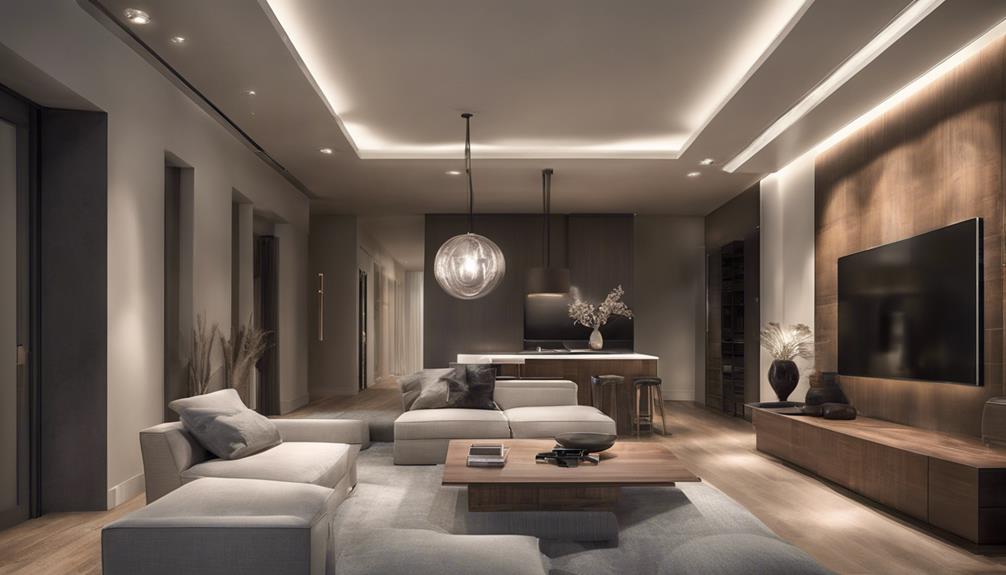
To infuse a modern touch into the revamped old house, we turn our attention now to the art of modernizing lighting fixtures, an essential element in transforming the ambiance and aesthetics of each room. Upgrading to modern lighting fixtures is a simple yet impactful way to elevate the look and feel of your living space. By installing recessed lighting, you can create a sleek and contemporary atmosphere that exudes sophistication. Incorporating pendant lights or wall sconces adds a touch of style and elegance, instantly modernizing your home. Not only does enhancing the lighting fixtures improve functionality by providing adequate illumination, but it also enhances the overall aesthetics of the house, making it more inviting. With these contemporary lighting upgrades, your old house will undergo a remarkable transformation, embracing a modern vibe that is both liberating and stylish.
| Lighting Fixtures | Modern | Upgrade |
|---|---|---|
| Recessed Lighting | Contemporary | Ambiance |
| Pendant Lights | Sophistication | Functionality |
| Wall Sconces | Stylish | Aesthetics |
Updating Kitchen and Bathroom
With a fresh coat of paint on the kitchen cabinets, a contemporary ambiance effortlessly permeates the space, initiating the modern transformation of the home. Updating kitchen cabinets with a modern hue can breathe new life into the heart of the house.
Swapping out outdated faucets and light fixtures in the bathroom for sleek, modern designs is a simple yet impactful change that can instantly elevate the space. Modern countertops and appliances in the kitchen not only enhance functionality but also bring a touch of luxury to the room.
Consider adding a trendy backsplash to create a focal point and inject personality into the kitchen. Upgrading bathroom vanities with sleek designs and modern finishes can transform the bathroom into a spa-like retreat.
Exterior and Interior Painting Ideas
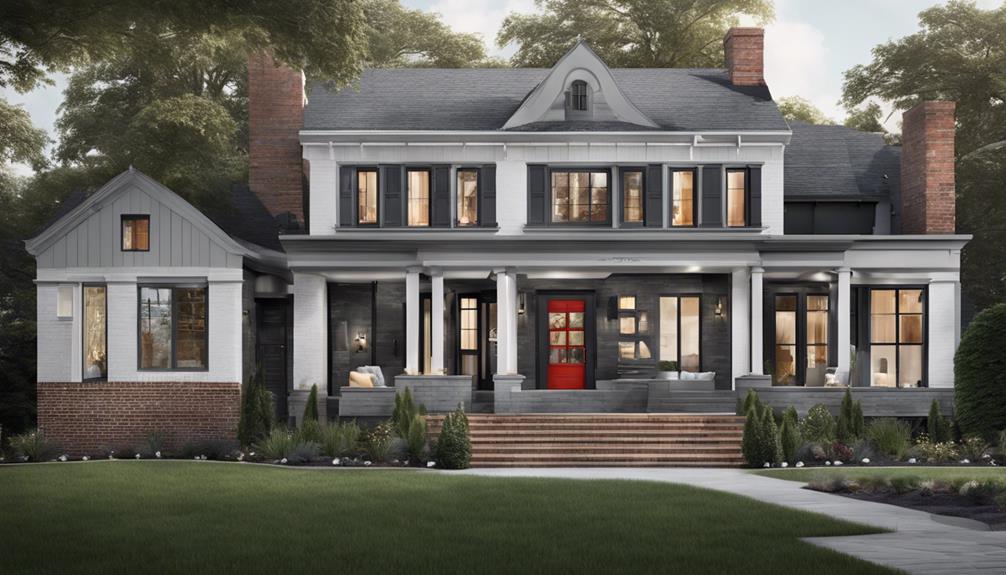
Embarking on a journey of visual rejuvenation, we explore innovative exterior and interior painting ideas to infuse our old house with a modern and vibrant aesthetic. Painting the exterior not only modernizes the look but also boosts curb appeal.
Inside, updating walls with modern colors instantly transforms the space into a contemporary oasis. For a stylish kitchen makeover, consider painting cabinets in trendy hues that scream modernity. Adding contrasting colors on trim and doors can provide a sleek and modern touch to any room.
To create a focal point, accent walls with bold paint choices bring a pop of color and a trendy vibe to your old house. By incorporating these painting ideas, we can effortlessly modernize our home and elevate its interior design to reflect a chic and contemporary style.
Enhancing Home's Character
Reviving the essence of our home's character involves restoring original features and updating outdated elements to infuse modernity while preserving its historical charm. When aiming to make the old new again, a balance between restoration and modernization is key. Here's a table outlining essential steps to enhance our home's character:
| Task | Description |
|---|---|
| Restore Original Features | Bringing back elements like woodwork and flooring can reconnect the space to its historical roots. |
| Update Fixtures | Swapping out old fixtures, switches, and hardware for contemporary ones can instantly modernize the home. |
| Choose Modern Paint Colors | Painting walls, cabinets, and doors with updated colors can significantly transform the home's look. |
| Renovate Furniture | Updating furniture pieces to complement the restoration work can elevate the overall aesthetic appeal. |
To achieve these transformations seamlessly, seeking professional help from experts like Thomas Buckborough & Associates is advisable. Their expertise can guide us in blending the allure of the old with the sophistication of the new, creating a home that exudes both charm and modernity.
Frequently Asked Questions
How Can I Make My Old House Look More Modern?
To make your old house look more modern, we can update light fixtures with sleek designs, swap traditional knobs for contemporary options, and add a fresh coat of paint in trendy colors.
Incorporating smart home technology like thermostats and energy-efficient windows can also enhance the modern feel.
How Do You Convert a Traditional House to Modern?
We convert traditional houses to modern by blending new materials with classic features, creating a seamless fusion of old and new. Our approach includes integrating smart technology for efficiency and sustainability, utilizing a neutral base with vibrant accents for a contemporary flair, and mixing vintage and modern elements for a unique and stylish outcome.
Our goal is to transform outdated spaces into sleek, functional, and visually pleasing environments that reflect modern living at its finest.
How Can I Update My House Without Remodeling?
We can update our house without a full remodel by painting kitchen cabinets, bathroom vanities, and doors for a modern look. Refreshing tile, floors, and countertops with paint can give a budget-friendly update.
Swapping out outdated light fixtures and door hardware adds a modern touch. Refinishing hardwood floors or choosing luxury vinyl are cost-effective ways to update the home's appearance.
Whitewashing or limewashing brick fireplaces can also provide a contemporary feel.
What Make a House Look Modern?
When we think about what makes a house look modern, we consider elements like clean lines, minimalistic design, and open floor plans. These features create a contemporary vibe that's both sleek and inviting.
Conclusion
As we put the finishing touches on our modernized old house, the blend of old charm and contemporary style creates a truly unique living space.
The restored flooring, updated lighting fixtures, modernized kitchen and bathroom, fresh paint, and enhanced outdoor areas have transformed our home into a modern oasis.
By combining classic elements with modern touches, we've created a space that's both inviting and stylish, a true reflection of our personal style and taste.
- About the Author
- Latest Posts
Introducing Ron, the home decor aficionado at ByRetreat, whose passion for creating beautiful and inviting spaces is at the heart of his work. With his deep knowledge of home decor and his innate sense of style, Ron brings a wealth of expertise and a keen eye for detail to the ByRetreat team.
Ron’s love for home decor goes beyond aesthetics; he understands that our surroundings play a significant role in our overall well-being and productivity. With this in mind, Ron is dedicated to transforming remote workspaces into havens of comfort, functionality, and beauty.
Architecture Home Styles
What Defines Modern Classic Home Style?
Wondering what makes modern classic home style so captivating? Dive into the blend of contemporary and traditional design elements that create a timeless and sophisticated living space.

Have you ever wondered what truly defines modern classic home style?
The concept of blending contemporary and traditional design elements to create a timeless yet sophisticated living space is intriguing.
Let's explore the intricate details and key characteristics that contribute to the allure of modern classic home style.
From the color palette and materials used to the incorporation of vintage decor elements, there's a delicate balance to be discovered that elevates the ambiance of any home.
Let's delve into the essence of this captivating home style.
Key Takeaways
- Harmonious fusion of modern and traditional aesthetics creates the essence of modern classic home style.
- Thoughtful curation of furniture pieces with various textures enhances the sophisticated ambiance.
- Incorporating vintage decor elements adds a nostalgic charm and timeless elegance to the space.
- Achieving a cozy yet sophisticated atmosphere through rich colors, textures, and a touch of luxury.
Characteristics of Modern Classic Home Style
In defining the Characteristics of Modern Classic Home Style, we encounter a harmonious fusion of modern and traditional aesthetics, creating a timeless allure. This style seamlessly blends sleek modern elements with classic furniture pieces, striking a perfect balance between innovation and tradition.
The interior design of a modern classic home embraces a sophisticated combination of clean lines and elegant curves, resulting in spaces that feel both contemporary and timeless. The color palette plays a crucial role in achieving this aesthetic, with rich warm neutrals, deep greens, navy tones, and vibrant pops of color adding depth and richness to the overall design.
When it comes to furniture selection, the key lies in the thoughtful curation of pieces that marry modern sensibilities with classic charm. Incorporating various textures such as linen, velvet, and quilted patterns further enhances the visual interest and tactile appeal of the space, creating a cozy and inviting atmosphere that's characteristic of modern classic style.
Color Palette and Materials
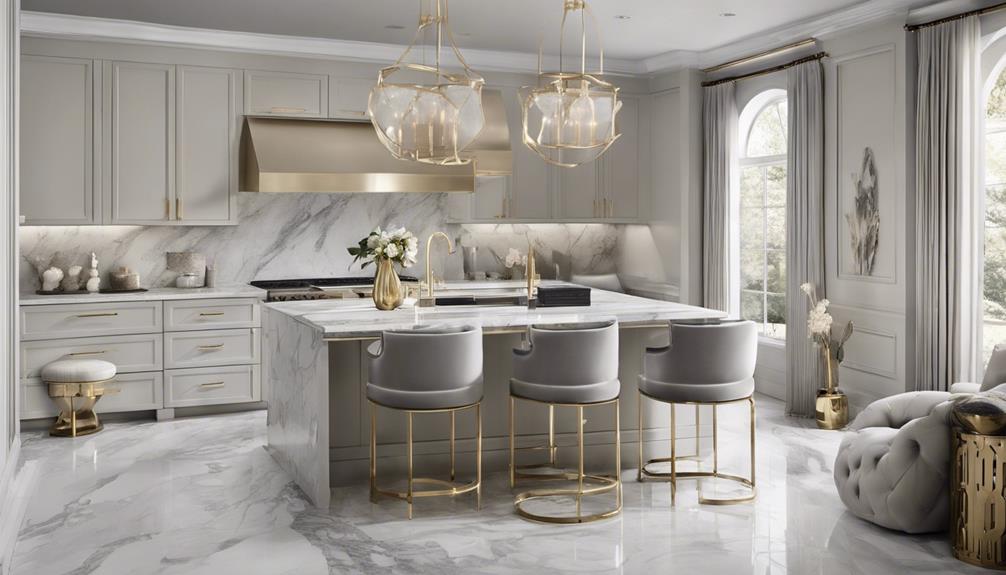
With a refined selection of main colors like brown, beige, black, silver, and white, modern classic home style achieves a harmonious balance in its color palette and materials, exuding a sophisticated allure that seamlessly blends tradition with modernity. Modern classic style combines simple and classic interior design elements to create the perfect ambiance in any interior space.
Here are some key aspects that define the color palette and materials used in modern classic design:
- Main Colors: The main colors of brown, beige, black, silver, and white set the tone for a modern classical style interior, offering a timeless and elegant look.
- Materials: Wood, steel, and glass are commonly used materials in modern classic design, providing a sense of sophistication and warmth to the space.
- Minimalist Touches: Minimalist touches and simple designs play a crucial role in achieving the modern classic aesthetic, ensuring a clean and organized appearance while still maintaining a sense of luxury.
Incorporating Vintage Decor Elements
Embracing vintage decor elements in modern classic home style infuses a sense of nostalgic charm and timeless elegance into the interior space. When selecting pieces for your modern classic design, consider incorporating elements from the Victorian and Art Deco eras to add a touch of history to your home. Antique brass frames holding vintage art prints can enhance the classic feel, while wooden accents like rustic textured vases and lamps bring warmth and character to the room. Personalize your space by adding small objects or old photos that hold sentimental value, creating a unique blend of past and present.
In choosing the perfect palette for your modern classic design, consider incorporating geometric patterned throw rugs as popular choices to add a contemporary flair. These rugs not only provide visual interest but also tie the room together harmoniously. By carefully curating a selection of vintage decor elements, you can achieve a cohesive and inviting ambiance that exudes sophistication and innovation.
Achieving Modern Classic Ambiance
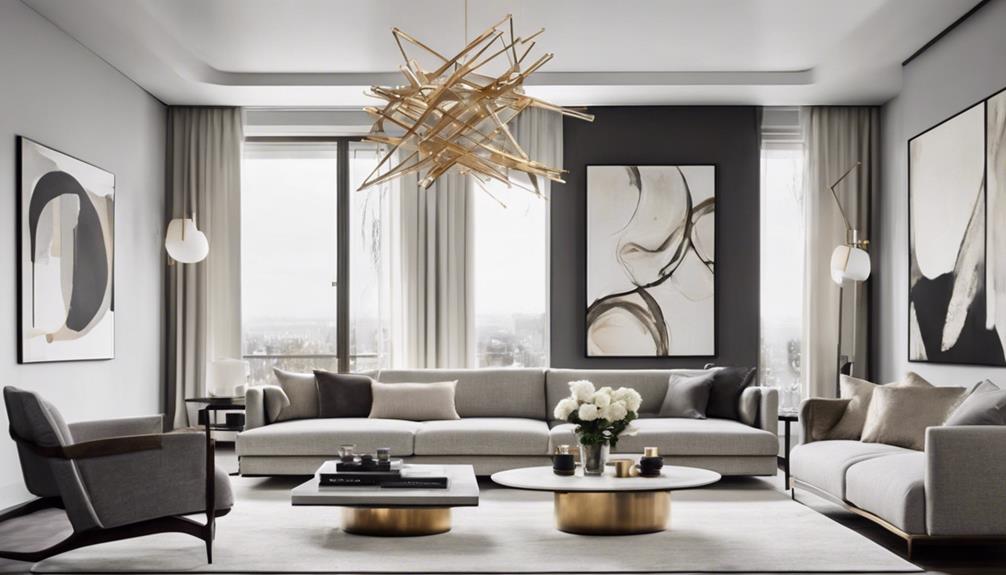
To cultivate a modern classic ambiance, blending modern and traditional design seamlessly is paramount, ensuring a harmonious fusion of warmth, rich colors, and timeless contrasts. Achieving the desired modern classic ambiance involves:
- Balancing Act: Blend modern and traditional design elements in a 3/4 to 1/4 ratio, where modern pieces dominate but traditional items add depth and character.
- Color Palette: Embrace rich colors like navy, deep greens, and warm neutrals to create a cozy yet sophisticated atmosphere that exudes elegance.
- Textural Depth: Incorporate textures like quilted patterns, velvet, and linen to add richness and tactile appeal, elevating the space with a luxurious touch.
Expert Tips for Home Styling
In our pursuit of creating a modern classic home style, we carefully blend modern and traditional design elements to achieve a seamless and harmonious aesthetic.
Expert tips for styling a modern classic home include seamlessly combining modern and traditional design for a timeless look. To achieve this, incorporate a mix of modern and mid-century furniture pieces in a 3/4 to 1/4 ratio for balance.
Choose timeless patterns and textures like quilted patterns, velvet, and simple prints to enhance the classic modern interior decoration. Opt for a warm and neutral color palette with rich neutrals, deep greens, navy, and warm brick tones to add richness.
Vintage decor elements can be included to add a casual and nostalgic touch to your modern classic home. By following these expert tips, you can create a space that effortlessly blends the best of both worlds in a sophisticated and innovative manner.
Frequently Asked Questions
What Is Modern Classic Home Style?
We believe that modern classic home style embodies a perfect fusion of contemporary and traditional design elements. It seamlessly blends sleek, modern lines with timeless furniture pieces, creating a look that transcends trends.
The color palette is carefully curated, featuring rich warm neutrals, sharp black contrasts, and vibrant pops of color. Vintage decor elements are thoughtfully incorporated for a touch of nostalgia and warmth, adding depth and character to the space.
What Is the Difference Between Modern and Classic Interior Style?
When distinguishing between modern and classic interior styles, the key lies in design elements, materials, and overall aesthetic. Modern design opts for sleek lines, minimalism, and functionality with materials like steel and glass.
In contrast, classic design embraces ornate details, intricate patterns, and rich colors using materials such as wood and marble.
The interplay between these contrasting approaches shapes the ambiance and character of a space.
What Is the Difference Between Modern and Classic House Design?
When comparing modern and classic house design, we notice distinct differences. Modern homes typically feature clean lines and open spaces, prioritizing functionality and innovation.
In contrast, classic houses boast ornate details and traditional craftsmanship, embracing timeless elegance and cultural influences. Modern design leans towards minimalism and industrial materials, while classic design values architectural embellishments and natural materials.
These distinctions showcase the evolution of home styles and the diverse preferences in architectural aesthetics.
What Is Classic Home Style?
Classic home style embodies timeless elegance with traditional furniture and sophisticated decor elements. It showcases ornate details, rich colors, and luxurious textures for a sense of grandeur. Drawing inspiration from historical design periods like Victorian and French Rococo, it features intricate carvings, curved lines, and plush upholstery.
Emphasizing symmetry and refined craftsmanship, classic style exudes a regal look that stands the test of time.
Conclusion
In conclusion, modern classic home style is all about blending the best of both worlds – the timeless elegance of traditional design with the sleek sophistication of modern elements.
By incorporating vintage decor pieces and a balanced color palette, you can create a space that exudes charm and sophistication.
Remember, the key to achieving modern classic ambiance is to embrace the unexpected and let your personality shine through in your decor choices.
So go ahead, make your home a reflection of your unique style!
- About the Author
- Latest Posts
Introducing Ron, the home decor aficionado at ByRetreat, whose passion for creating beautiful and inviting spaces is at the heart of his work. With his deep knowledge of home decor and his innate sense of style, Ron brings a wealth of expertise and a keen eye for detail to the ByRetreat team.
Ron’s love for home decor goes beyond aesthetics; he understands that our surroundings play a significant role in our overall well-being and productivity. With this in mind, Ron is dedicated to transforming remote workspaces into havens of comfort, functionality, and beauty.
Architecture Home Styles
How Victorian Homes Did Have High Ceilings: A Complete Guide
Yearning to uncover the mysteries of Victorian homes with their iconic high ceilings? Discover the secrets behind this architectural marvel and be captivated!

We've all marveled at the grandeur of Victorian homes, and did you know that high ceilings were a defining feature in 95% of them?
This architectural choice wasn't just about aesthetics; it served a practical purpose that continues to influence modern design.
As we unravel the secrets behind how Victorian homes embraced the sky above, you'll discover a world where ceilings weren't just a blank space but a canvas for creativity and elegance.
Curious to uncover the hidden stories woven into these lofty spaces and how they can inspire our own living environments?
Key Takeaways
- High ceilings in Victorian homes symbolized wealth and grandeur.
- Ornate plaster medallions and chandeliers adorned lofty ceilings.
- Spaciousness allowed for elaborate decor and improved ventilation.
- Victorian ceilings ranged from 10 to 14 feet, enhancing vertical grandeur.
Historical Significance of High Ceilings
With high ceilings serving as a poignant symbol of grandeur, wealth, and social status in the Victorian era, their historical significance transcends mere architectural design. Victorian homes of this era embraced high ceilings not only for their aesthetic appeal but also for their functional benefits. The elevated ceilings facilitated improved air circulation and ventilation within the interior spaces, ensuring a more comfortable living environment. Moreover, the spaciousness created by high ceilings contributed to the overall grandeur of Victorian houses, allowing for the inclusion of elaborate chandeliers, decorative moldings, and tall furniture pieces that epitomized luxury and sophistication.
The architectural style of Victorian homes strategically incorporated high ceilings to enhance the sense of verticality and grandeur within the living quarters. This design choice not only visually expanded the interior spaces but also added a sense of majesty to the overall ambiance. The presence of high ceilings in Victorian homes reflected the societal values of the time, showcasing opulence and refinement through architectural innovation.
Architectural Elements of Victorian Ceilings
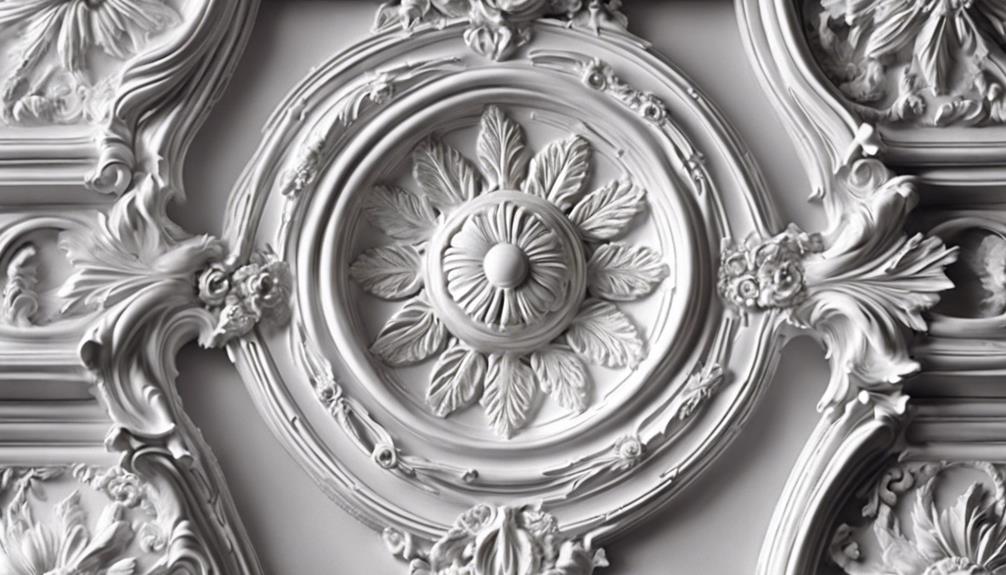
Embellishing Victorian ceilings with ornate plaster medallions, intricate moldings, and decorative rosettes heightened the elegance and sophistication of the interior spaces. These architectural elements played a crucial role in defining the grandeur of Victorian ceilings:
- High Heights: Ranging from 10 to 14 feet, Victorian ceilings emphasized vertical space, creating a sense of openness and grandeur in rooms.
- Ornate Designs: Plaster medallions, intricate moldings, and decorative rosettes adorned Victorian ceilings, adding intricate detailing and visual interest to the overhead space.
- Hand-Painted Frescoes: Victorian ceilings often featured hand-painted frescoes, stenciling, or wallpaper, serving as unique focal points that showcased artistic craftsmanship.
- Elaborate Light Fixtures: Large chandeliers and ornate light fixtures were commonly used in Victorian ceilings to complement the lofty heights, infusing a touch of opulence and enhancing the overall aesthetic appeal of the room.
These elements not only contributed to the visual appeal but also facilitated better air circulation and natural light, enhancing the comfort and ambiance of Victorian interiors.
Practical Benefits of High Ceilings
High ceilings in Victorian homes provided essential practical benefits that significantly influenced the comfort and aesthetic appeal of the living spaces. The increased vertical space allowed for better air circulation and ventilation, crucial in an era before modern air conditioning. This unique feature not only promoted a healthier indoor environment but also contributed to the grandeur and opulence of Victorian interiors.
The spaciousness created by high ceilings lent a sense of luxury to these homes, accommodating elaborate chandeliers and light fixtures that added to their charm. Additionally, tall windows designed to fit these lofty spaces allowed natural light to flood into the rooms, creating a bright and inviting atmosphere.
Furthermore, the ample wall space provided by high ceilings was ideal for displaying large and ornate artwork, showcasing the homeowner's wealth and status in a visually striking manner. The practical advantages of high ceilings in Victorian homes truly enhanced both functionality and aesthetics, making them a hallmark of architectural innovation during that era.
Design Tips for Embracing High Ceilings

Optimizing the spatial layout of rooms with lofty ceilings involves strategically integrating design elements to enhance the overall aesthetic and functionality of the space. When embracing high ceilings in Victorian homes, consider the following design tips:
- Elaborate Chandeliers: Utilize the vertical space to hang ornate chandeliers that accentuate the height of the room while providing ambient lighting.
- Spaciousness: Embrace the sense of openness high ceilings offer by avoiding clutter and opting for minimalist decor that complements the grandeur of the space.
- Natural Light: Maximize the presence of large windows by using sheer curtains or no window treatments to allow natural light to flood the room, enhancing its charm.
- Tall Furniture Pieces: Select tall furniture like towering armoires or floor-to-ceiling bookcases to make use of the vertical space without overwhelming the room, adding to the luxurious feel associated with Victorian interiors.
Maintaining Victorian Ceilings: Tips and Tricks
Maintaining the integrity of Victorian ceilings requires consistent upkeep to preserve their intricate details and historical charm. With heights typically ranging from 9 to 12 feet, Victorian ceilings impart a sense of grandeur and spaciousness to rooms, exuding elegance. Regular dusting and cleaning are essential to safeguard ornate moldings, plasterwork, and decorative detailing that define these ceilings. When it comes to restoring Victorian ceilings, professional expertise may be necessary to address issues like cracks, water damage, or paint chipping while ensuring historical authenticity is maintained.
The ornate medallions, rosettes, and cornices often found on Victorian ceilings contribute to their aesthetic appeal, adding sophistication and character to any space. To further enhance the beauty of these ceilings, selecting appropriate lighting fixtures can illuminate the intricate designs and architectural elements, creating a captivating visual impact. By embracing these tips and tricks for maintaining Victorian ceilings, one can uphold their unique charm and historical significance for years to come.
Frequently Asked Questions
Why Did Victorian Houses Have Such High Ceilings?
We believe Victorian houses had high ceilings primarily to evoke a sense of opulence and prestige. The towering heights lent an air of grandeur and spaciousness, reflecting the affluence and social standing of the occupants.
Moreover, the tall ceilings facilitated better air circulation and ventilation, essential in an era devoid of modern HVAC systems. This architectural choice also allowed for the incorporation of elaborate crown moldings, chandeliers, and other ornate decorations popular during that period.
What Was the Average Height of a Victorian House?
On average, Victorian houses typically had ceiling heights ranging from 9 to 12 feet per story, resulting in overall heights of 18 to 24 feet for a two-story dwelling.
The emphasis on grandeur and spaciousness in Victorian architecture led to the incorporation of higher ceilings. This design choice allowed for improved air circulation, better natural light penetration, and an overall sense of openness within the interior spaces of these homes, reflecting the elegance and opulence of the era.
What Are the Architectural Details of Victorian Houses?
High ceilings in Victorian homes showcase ornate crown moldings, ceiling medallions, and intricate plasterwork. These architectural details add a touch of elegance and sophistication, enhancing the overall aesthetic.
Elaborate chandeliers, pendant lights, and ceiling fans often adorn these lofty spaces, creating a sense of grandeur. Vaulted ceilings, decorative beams, and skylights further elevate the design, reflecting the opulence of the Victorian era.
What Is the Typical Victorian House Layout?
In a typical Victorian house layout, we find multiple stories with high ceilings that create a grand and airy atmosphere. The design emphasizes vertical space, incorporating cozy nooks, intricate staircases, and ornate trim work.
Rooms are often compartmentalized, each designated for specific activities, reflecting the social norms of the era. These high ceilings add to the overall opulence and spaciousness of Victorian homes, showcasing a luxurious and elegant interior design.
Conclusion
In conclusion, high ceilings in Victorian homes weren't just a design choice, but a symbol of prestige and grandeur. They reached for the sky, quite literally, creating an illusion of grandeur and openness.
Embracing this architectural feature can truly elevate the aesthetic of a space, adding a touch of old-world charm and sophistication.
So, when it comes to interior design, remember that the sky's the limit when it comes to Victorian high ceilings.
- About the Author
- Latest Posts
Introducing Ron, the home decor aficionado at ByRetreat, whose passion for creating beautiful and inviting spaces is at the heart of his work. With his deep knowledge of home decor and his innate sense of style, Ron brings a wealth of expertise and a keen eye for detail to the ByRetreat team.
Ron’s love for home decor goes beyond aesthetics; he understands that our surroundings play a significant role in our overall well-being and productivity. With this in mind, Ron is dedicated to transforming remote workspaces into havens of comfort, functionality, and beauty.
-

 Vetted6 days ago
Vetted6 days ago15 Best Printers of 2024: Top Picks and Expert Reviews
-

 Vetted1 week ago
Vetted1 week ago15 Best Tile Sealers for Long-Lasting Protection and Shine
-

 Vetted2 weeks ago
Vetted2 weeks ago15 Best Smelling Floor Cleaners That Will Leave Your Home Fresh and Inviting
-

 Vetted5 hours ago
Vetted5 hours ago14 Best Lawn Tractors of 2024 – Ultimate Guide for Your Yard Maintenance
-

 Vetted1 week ago
Vetted1 week ago14 Best Power Scrubbers for Showers That Will Transform Your Cleaning Routine
-

 Vetted3 days ago
Vetted3 days ago15 Best Evergreen Plants for Shade Gardens: A Complete Guide
-

 Vetted3 days ago
Vetted3 days ago15 Best LED Dimmer Switches With No Flicker: Ultimate Guide for a Flicker-Free Lighting Experience
-

 Mardi Gras Decoration5 days ago
Mardi Gras Decoration5 days agoWhat Do the Symbols of Mardi Gras Mean?




